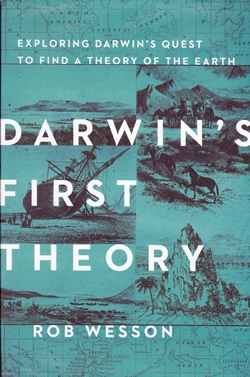 Darwin's First Theory - Exploring Darwin's quest to find a theory of the Earth
Darwin's First Theory - Exploring Darwin's quest to find a theory of the Earth
I have never passed up the opportunity to remind the world that Darwin was, primarily, a geologist, nor that he owed his biological insight to the unique world view of a geologist, who sees objects – be they landforms or species - not as perfect objects, but as the end result of historical processes. And lo, on the very day I write this review of Rob Wesson's admirable and hugely enjoyable examination of Darwin's geological researches, my colleague Oliver Morton at The Times writes (in a box-text about the great man): "Charles Darwin - A geologist by training...".1
Clearly, the message is getting through, and this hugely readable book will ensure it is heard more widely – especially perhaps across the Atlantic. Wesson has made it his task to examine Darwin the geologist, from 'training', at the hands of Adam Sedgwick, to his many significant geological contributions, notably on the uplift of the Andes, the subsidence of Pacific coral islands, and his less successful brush with glacial theory, which eventually trumped his eustatic explanation for the Parallel Roads of Glen Roy.
Wesson, a geophysicist with USGS who (we gather) was 'seduced' by mathematical modelling early on and spent much of his life since in front of a computer, traded all that for some camping equipment and a trenching tool to get back in the field, retracing Darwin's extensive footsteps in company with field geologists. Thus we encounter him - from Cwm Idwal to Glen Roy, Patagonia to the Isla Santa Maria, where Darwin and Fitzroy noted the abrupt raising of the shoreline following the 1835 earthquake which destroyed Concepcion and Valparaiso during the Beagle voyage. This event, life-changing for Darwin, was paralleled by the 2010 Chilean earthquake, which thus enables the author to compare, contrast and fit both events into a modern plate tectonic framework, excitingly interlacing his dual narratives as he goes. It is a compelling tale, engagingly told.
Away from tectonics and seismology, Wesson occasionally finds himself on shaky ground - notably in palaeontology, over-egging the asteroid strike at the end of the Cretaceous, which progressive opinion now views as one factor among many - no mass extinction ever having a single cause - and prime importance in that case resting instead with the Deccan Trap eruptions.
I could have done, too, without all the trade-names (I won't mention them again, but the repetition of various brands of outdoor gear and motor vehicle brought out the Lord Reith in me). Nor did I see the reason behind granting any publicity oxygen to those pernicious young-Earthers who masquerade as scientists and seek to portray 'Darwin's first theory' as his 'first big mistake', for their own fraudulent purposes.
But these blemishes, if such they are, are minor. Others may not even find them so. Although it can and should be read for pleasure and profit by all, principally this is a book for Americans - 42% of whom, it seems from a recent survey, prefer believing their Bible over what geologists say about the age and origin of the Earth; a lamentable fact that reduces the human race's already slim chance of escaping its own imminent extinction even further, Wesson concludes.
Reference
- Morton, O: 'Class of 2017 dumber than Victorians'. The Times 72278 July 18, p15
Reviewed by Ted Nield
DARWIN'S FIRST THEORY - EXPLORING DARWIN'S QUEST TO FIND A THEORY OF THE EARTH by ROB WESSON 2017 Pegasus Books ISBN 978-1-68177-316-2 457pp (hbk) List Price $29.95 www.pegasus.com
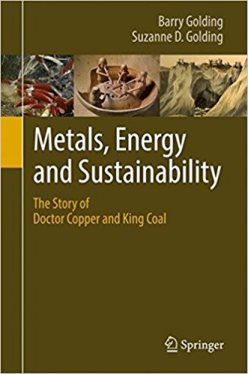 Metals, Energy and Sustainability - the Story of Doctor Copper and King Coal
Metals, Energy and Sustainability - the Story of Doctor Copper and King Coal
In our era, as global challenges rightly take centre stage, this book is very timely. The imperative to confront human-induced degradation of climate, soil fertility, ecosystems and freshwater resources must be reconciled with the need to provide the burgeoning human population with sustenance, shelter, healthcare and other means of comfort and pleasure. The scale of these challenges can feel overwhelming. Yet this highly readable book, of only four chapters, provides a worked example of how much insight can be obtained by rigorous scrutiny of the interdependencies between just two Earth resources.
Having worked in and around coal and copper mines for decades, I imagined I would learn little from this book. I was very much mistaken. I soon realised I was learning something important on every other page.
The first chapter gives an engaging explanation of how and why, among all the world’s mined commodities, copper and coal remain pre-eminent in social and economic importance. The second chapter is essentially geological, summarising the principal economic occurrences of copper and coal deposits. The third chapter provides a historical overview of the technology and economics of exploitation of both commodities – over seven millennia in the case of copper, and over several centuries in the case of coal. The final chapter considers the future of both commodities, examined quantitatively within a framework of holistic sustainability.
The narrative confounds the customary over-simplifications which dominate the qualitative literature on sustainability. For instance, renewable energy technologies use far more copper than conventional fossil-fuel technologies. So to advocate massive expansion of renewable energy use is to demand an expansion and intensification of copper mining and refining.
The lively prose and striking colour illustrations make for an enjoyable read. Quibbles are few and minor. I spotted just two minor typos (of the ‘to/too’ variety), and in chapter three, I missed scale-bars on ore specimen photos, and would have liked more thorough labelling. These pale into insignificance alongside the depth and breadth of this volume. It is essential reading for anyone interested in the contemporary interface between economic geology and sustainability debates.
Reviewed by Paul L Younger
METALS, ENERGY AND SUSTAINABILITY - THE STORY OF DOCTOR COPPER AND KING COAL by BARRY GOLDING & SUZANNE D GOLDING, 2017. Published by Springer, Cham (CH). ISBN (print) 978-3-319-51173-3, ISBN (electronic) 978-3-319-51175-7. 196pp. List price: Hbk £44.99. e-book £35.99. Springer books
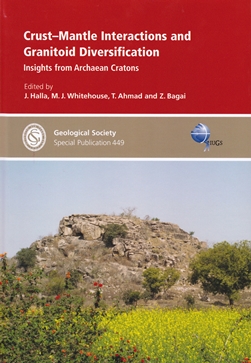 Crust-Mantle Interactions and Granitoid Diversification – Insights from Archaean Cratons
Crust-Mantle Interactions and Granitoid Diversification – Insights from Archaean Cratons
Based upon contemporary (2011-2015) research from the UNESCO-IGCP project ‘The Changing Early Earth’, this GSL Special Publication documents the evidence for fundamental change in the tectonics and magmatism on the Archaean Earth. Initial mafic magmas (erupted as oceanic crust, island arcs or plateaus) evolved through to the calc-alkaline Tonalite – Trondhjemite – Granodiorite (TTG) rock suites of accreting microcontinents, to the diversity of late Archaean granitoids generated at thick convergent continental margins.
An overview paper introduces the research context, including an essential background section on the specific terminology associated with the geochemical (compositional) nomenclature and classification, characteristic features, age relations and temporal – spatial patterns of Archaean granitoids. The volume contains three main regionally-based thematic sections of seven papers: Mesoarchaean Volcanic Supracrustals from Greenland, Mantle-derived Alkaline Rocks from Western Karelia (Fenno-Scandian Shield) and Mantle to Crustal Melting in the Indian Shield. A final section of three papers presents current insights derived from associated studies in metamorphic petrology.
The contributions chronicle the development of crust-forming magmatism from minor early Archaean (Eoarchaean) crust-mantle interactions to the appearance of extensive multisource granitoids, exhibiting crustal recycling (via mantle and intra-crustal reworking) at the end of the Archaean. These insights significantly expand the debate on the origin of Archaean igneous rocks and their role in deciphering Archaean crustal evolution and tectonics, providing new evidence for increasing crust-mantle interactions, granitoid diversification and the changing plate tectonic ‘style’ operating towards the end of the Archaean. The overall conclusion is the pre-eminence of convergent tectonic regimes over plume tectonics as the main crustal growth mechanism since the Eoarchaean.
The volume provides an excellent overview of the recent interdisciplinary geoscientific developments within this important and evolving field. The contributions are well-written and edited, complemented with appropriate figures, photographs and data-tables, features that one has come to expect from the GSL Special Publication series. A minor presentational criticism is that a couple of field photographs appear to have colour ‘bled’ in the print copy obtained by this reviewer, unfortunately distracting from the feature details described.
In summary, the editors and contributors are to be congratulated. An informative and recommended read.
Reviewed by Mark Griffin
CRUST-MANTLE INTERACTIONS AND GRANITOID DIVERSIFICATION – INSIGHTS FROM ARCHAEAN CRATONS by HALLA, J, WHITEHOUSE, M J, AHMAD T AND BAGAI, Z (editors). Geological Society of London Special Publication No 449. 2017. Geological Society of London. ISBN 978-1-78620-280-2. Hbk. 256pp. ISSN 0305-8719. List Price: £110.00, Fellows’ Price £55.00. Geological Society website
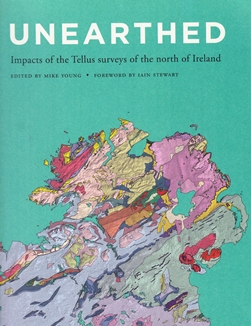 Unearthed: Impacts of the Tellus Surveys of the North of Ireland
Unearthed: Impacts of the Tellus Surveys of the North of Ireland
Low-flying (56m) aircraft criss-crossing the country, soil augers and waders were the order of the day. The Tellus project itself is described in the Foreword as a ‘land and air offensive’. It was 10 years of geophysics and geochemistry costing €15 million that systematically covered the land of a nation, and a bit of its neighbour.
It is ground mostly covered with the thick debris of the last glaciation so, with excellent surface geological maps the geophysics takes the reader to a lower level, literally unearthing the rocks. Measured from the air are the magnetic field, electrical conductivity and gamma radiation; and the results can only be described as spectacular, as demonstrated by the many colourful illustrations.
The geochemistry is based on systematic sampling of soils and stream sediments. The list of elements detected and quantified includes not just the likes of gold, silver and lead but dozens of others some of which would help on BBC’s ‘Pointless’. The rarer elements can just as easily effect the health of agricultural livestock as the obvious ones like arsenic.
The book advertises the fact that an enhanced national framework of environmental information is established - and the 30 sections, written by 69 authors, show how the data is already being used in spin-off research. Some is pure research, like the study of the Newry Igneous Complex and that of the Mourne Mountains. Others suggest new targets for mineral exploration, while a large number look at health issues of the environment (pollution/wetlands) and people. The combination of environmental and medical data is discussed, suggesting links with cancer, renal and other diseases; and there is a section on in-house radon measurements. The discussion of geoforensics, where soil on a suspect’s shoes might lead to an area where the swag or the body is buried, smacks of Sherlock Holmes.
It is a book that most people will not read throughout, but will dip into according to their interests. It is well laid out and early on gives detailed information about how to engage potential stakeholders and communicate with the public; critically important these days. Flick through the pages and you will see from the small maps that ‘a picture paints a thousand words’.
The cutting-edge methodologies and statistics point to areas of potential interest or problem rather than closely identifying them. As such it will long continue to stimulate research, be of practical value and generally fascinate.
Reviewed by Tony Bazley
UNEARTHED: IMPACTS OF THE TELLUS SURVEYS OF THE NORTH OF IRELAND edited by MIKE YOUNG, 2016. Published by: Royal Irish Academy 423pp ISBN:978-1-908996-87-9 List Price: €30 Website
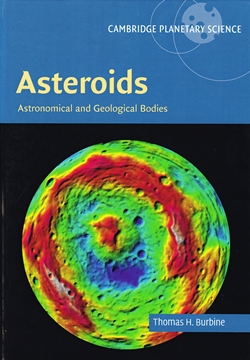 Asteroids: Astronomical and Geological Bodies
Asteroids: Astronomical and Geological Bodies
For most of the time since the discovery of (1) Ceres in 1801, asteroids, those enigmatic lumps of rock (?) mostly condemned to wander the Solar System between the orbits of Mars and Jupiter, have been little more than flecks of light on a photographic plate or CCD detector. How things have changed! Spurred on by the realisation that asteroids can deal life-extinguishing hammer-blows to the Earth, truly stupefying advances in the technology of detectors (including their use in automated discovery and photometric systems) and (since 1991) the attention of robotic spacecraft, the nature, diversity and significance of these bodies are now major areas of intense study.
Burbine’s book is intended as ‘...a reference book for anybody wanting to learn more...’ about the smaller bodies of the Solar System (which term now includes, controversially at least in the popular eye, Pluto – or should I say (134340) Pluto?). I believe it succeeds in this objective. Its best feature is the comprehensive coverage of the subject it provides. All the arcana needed to understand asteroids is here, everything from the history of discovery, orbital mechanics, spectroscopy, photometry and more to the threats these bodies pose to the Earth’s ecosystems.
The main classes of objects (of which there now seems to be a bewildering variety) are described and there are also competent introductions to the supporting cast of meteorites, comets and related bodies. All of this is commendably up to date, with the initial results of the latest spacecraft missions (Rosetta/Philae, New Horizons) included. The duplication of many of the more complex illustrations as colour plates is to be commended.
However, the desire to cover so much background material is also, perhaps, the book’s one failing. Some of the explanations, for example those of orbital mechanics, are somewhat cryptic and often become little more than jargon. Though I consider myself reasonably well-versed in some of these subjects, I did find such material difficult to follow in places. In Burbine’s defence he does suggest that the reader should have a ‘college-level knowledge’ of physics, mathematics, chemistry, geology and astronomy…'! Phew, who said the age of the polymath was dead?
Overall, this is a book to be recommended. As a ‘one-stop shop’ on all matters asteroidal it could hardly be bettered. Those wanting to know more about the geology of these bodies will have to look elsewhere, but they can start with this book’s excellent reference list.
Reviewed by Trevor F Emmett
ASTEROIDS: ASTRONOMICAL AND GEOLOGICAL BODIES by T H BURBINE. Cambridge Planetary Science Series no. 17. Cambridge University Press 2016 ISBN: 9781107096844. 394 pp (hbk) List Price: £49.99. Website
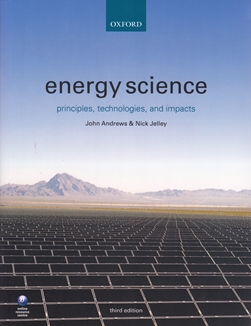 Energy Science: Principles, technologies, and impacts
Energy Science: Principles, technologies, and impacts
It was not entirely coincidental that this book dropped through my letterbox a day after the latest G20 conference ended. I was already in need of a reliable scientific update on where we stand on global warming. The situation changes fast, these days.
And here I have it, with a cover displaying a brick wall (of solar panels) leading up to a bare, mountainous horizon. An implication of global extinction, I assume. Inside, a framework of physics, mathematics and financial analysis delivers a heady excess to the brain. The book is well laid out, dressed with the latest statistics and each chapter embalmed with a short summary, recommendations for further reading and a set of exercises (answers at the back). Compared with the 2013 edition, this new edition has been comprehensively revised and is 100 pages (20%) longer.
The authors’ terminal sentence is disturbingly vague. It reads thus: ‘Currently, the rise in long term temperature may be limited to 2.7 degrees C by 2100, but only by enacting all the intended contributions of the nations announced in the Paris Agreement in 2015’. That is a hefty ask, particularly as these nations need to deal with a whole range of other (often unpredictable) issues as well. And decidedly more difficult to do now that a new inward-looking, unpredictable, US president has refused to reaffirm that 2015 agreement.
The content of this book is focused on a minority group: scientists. For me, reading it was like ploughing through a field of glutinous mud, full of sticky formulae and arresting acronyms (a loose page re-expanding all those puzzling acronyms would help). Cutting a satisfactorily straight comprehension furrow is tricky and tiring. It’s worth the effort in the end, but it’s no more accessible to the general public than the man in the moon.
That means we must do more to win over the public and their political representatives, and lead them to understand our logical, scientific, point of view. Just replacing the cover design with a copy of Edvard Munch’s dramatic ‘The Scream’, is tempting, but simply won’t do. We need to re-express the essence of this work in simpler language. The matter is too important to permit uninformed dissent. Perhaps, like Mrs Bucket (sorry, ‘Bouquet’), we should sing more at the unconverted than with them. Short of creating a scientific meritocracy, that’s all we can do.
Reviewed by David Edwards
ENERGY SCIENCE: PRINCIPLES, TECHNOLOGIES, AND IMPACTS by JOHN ANDREWS & NICK JELLEY (3
rd
Edn). 2017. Oxford University Press. ISBN-13: 978-0199281121 344pp (sbk). List Price £39.99. Website